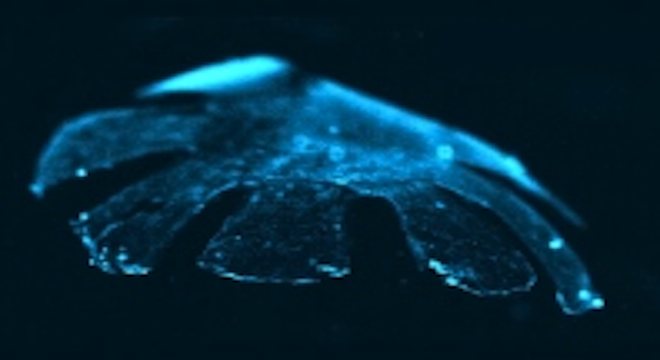It’s not the plot of a summer monster movie: Scientists have created jellyfish-like organisms made out of rat heart cells and silicone that swim like their natural counterparts when activated by an electrical current.
The advancement, first reported in a scientific paper published in the journal Nature Biotechnology on July 22, should help spur the development of artificially-grown human organs, including organs that are more resilient and better at their jobs than natural ones, according to the researchers behind the jellyfish.
“This new freedom could in fact lead to design solutions better suited for bio-engineered materials and outperforming even the natural organs (since evolution does not necessarily lead to the most optimal solution as it can only modify the genes/materials at hand),” wrote Janna Nawroth, a biologist at the California Institute of Technology, who worked with colleagues at her institute and at Harvard to develop the tiny creatures, in an email to TPM.
The medusoids, as the creatures are known, measure just 9 millimeters across and have eight separate “legs,” which twitch and cause the entire creature to “pump” fluid around it, causing them to swim.
See the creatures in motion in the following video from Nature:
Nawroth “built” about 30 medusoids, she said in her email to TPM. The creatures were created by placing rat heart muscle cells onto flexible sheets of polydimethylsiloxane, a type of silicone compound used frequently in human medical implants, cut into the eight-legged shape of a moon jellyfish, a naturally-occurring creature found in ocean waters around the globe.
The moon jellyfish was chosen as a model due to its particular method of swimming, Nawroth explained.
“We could not use any jellyfish type (most of which are circular) because a silicone rubber disc does not easily ‘wrinkle’ into a bell,” Nawroth wrote. “We solved this by looking for jellyfish species that avoid compression when contracting, and we found a good solution in the juvenile moon jellyfish: Their lobed geometry allows for compression-free folding into a bell shape.”
The rat heart muscle cells were then cultivated, or grown, into the eight-legged shape. The medusoids consisted of 80 percent silicone and 20 percent rat heart cells, according to Nawroth.
The finished medusoids were then placed in water — specifically a salt water solution — and two electrodes placed on either side. When a current was run through the solution, the muscle cells quickly tensed and contracted, pulling the medusoid’s eight legs inward. The elastic silicone web on which the rat cells were grown allowed the legs to relax and spring back to their original shape. This contraction-relaxation cycle propelled the organisms through the solution like the actual moon jellyfish, upon which their structure was based.
Still, Nawroth said that it would not be fair to call the medusoids “living” creatures of their own accord. At least not yet.
“I would call it a hybrid or pseudo organism because it consists of living and synthetic materials, and while it does not have a mind on its own, it responds to stimuli,” Nawroth wrote. “Also, the living components of the Medusoid have a (limited) capacity of self-repair and re-growth, which distinguishes this construct from a traditional robot.”
But Nawroth told TPM she believes that the medusoid research has laid the groundwork to developing far more sophisticated hybrid natural-synthetic organisms, and eventually full working human organs, which can be used as transplants. In particular, Nawroth said that marine life, and specifically marine invertebrates, or spineless creatures, were great models for such research.
“The sea cucumber is capable of being very stiff and thick one moment, and then again it can become very soft and squeeze itself through tiny holes in the next moment,” Nawroth explained. “This is a fascinating mechanism that could be useful for debris searching robots but also medical devices and prosthetics, and maybe it can be recreated if we combine living tissue (muscle) with synthetic materials.”
That said, it may be some time before such an experiment is repeated with human cells due to research laws.
“The legal restrictions placed on using human cells and tissues (other than cancers) are such that any ‘fooling around,’ however, is rather unlikely,” Nawroth wrote. “They will only be used once techniques for growing proper organs/drug testing platforms have been established.”
Asked about the ethical implications of creating hybrid living-nonliving organisms, Nawroth said that the ultimate goal was to do away with the need to experiment on living subjects, and thus the ethical determination was made that the longterm benefits could outweigh any short-term issues or concerns.
“These experiments have as their long-time goal the reduction/replacements of animal experiments and organ transplants,” Nawroth told TPM. “We think that these goals warrant the costs and ethical conflicts associated with using rat hearts.”






